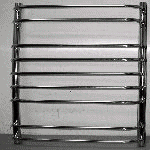




|
Technology
(Electrolyte-Plasma Machining Basics)
Electrolyte-Plasma Technology is based on physical-chemical processes taking place near surface of electrodes in solutions of mineral salts in the conditions of high electrical potential.
 The treatment article is an anode in the technology of electrolyte-plasma treatment which a positive potential is supplied to, but a processing bath is a cathode (Fig. 1).
The treatment article is an anode in the technology of electrolyte-plasma treatment which a positive potential is supplied to, but a processing bath is a cathode (Fig. 1).
Passing an electric current through electrolyte cell containing two metal electrodes, one of which (anode) has rather less surface than the second one, leads to different phases of the process at gradual increasing of voltage on electrodes. These phases can be observed at volt-ampere characteristic (Fig. 2).
On section CD under the voltage of more than 200 V a stable gas-vapour envelope is formed around the anode, which is characterized by small current vibrations at U=const. In this range of voltages (200-300 V) and current densities of 0.2-0.6 A/cm² an electrolyte-plasma treatment takes place. A drooping character of the volt-ampere characteristic can be considered as resistance rise in the circuit at voltage increasing. It can be explained by increasing the thickness of gas-vapour film having a high specific resistance.
 Section CD is an operating zone on the volt-ampere characteristic at impulse electrochemical treatment, when a continuous stable gas-vapour envelope (GVE) exists around the treated article (anode). Its stability and continuity are determined by a set of different parameters, such as electric characteristics of the circuit, thermal conditions on the treated surface, molecular properties of the electrolyte and hydrodynamic parameters of the liquid in the near-electrode zone.
Section CD is an operating zone on the volt-ampere characteristic at impulse electrochemical treatment, when a continuous stable gas-vapour envelope (GVE) exists around the treated article (anode). Its stability and continuity are determined by a set of different parameters, such as electric characteristics of the circuit, thermal conditions on the treated surface, molecular properties of the electrolyte and hydrodynamic parameters of the liquid in the near-electrode zone.
A continuous GVE around the anode has the thickness of 50 mkm (dmid) and changes its shape constantly. Superimposing of electrical field distorts the surface of the electrolyte. This explains the approach of bulging sections of the surface of the electrolyte to the metal anode, that, in its turn, leads to the rise of vapour pressure in this place and throwing-away of the electrolyte. As a result vibrations of gas-vapour envelope are formed with the period of 10-50 ms.
Electric intensity in the envelope reaches 104-105 V/cm. Under the temperature of about 100°C such intensity is able to give rise to vapour ionization, as well as ion and electron emission necessary for keeping up a stationary glow electric discharge in the envelope, stipulating its conduction and glow mainly. Electric intensity increases near microshoulders, and pulse spark discharges appear on these sections which are seen by travelling bright spots.
|
 |
